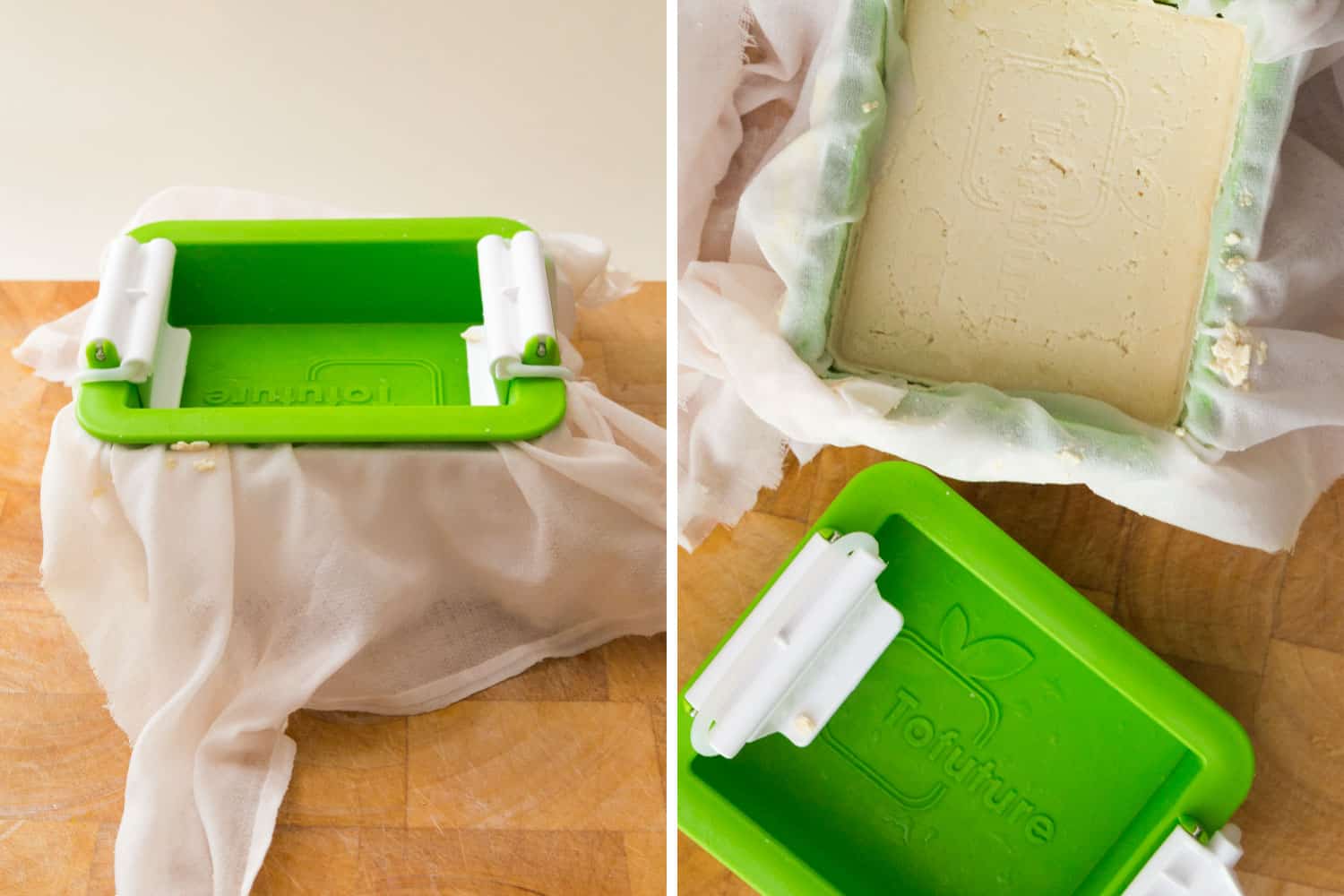2018 update: I get a reasonable number of questions about whether or not to purchase a soy milk maker. I personally do not like them. Firstly because the one I had literally caught fire. Second, it is an unnecessary gadget since I have a high powered blender. I am a fan of a couple of solid kitchen workhorse appliances over several pieces that save insignificant amounts of time. Having said that, I have talked to several people who swear by their soy milk makers. There isn't a right or wrong choice with regards to how you choose to make your own soy milk. Both options work fine.
Tofuture, a small UK business run by tofu devotees Susanna and Adam, recently sent me a sample of their tofu maker and press to try out. I have approximately zero interest in gadgets like these, so found myself pleasantly surprised at how much I enjoyed this product. Most tofu pressing devices are just that: tofu pressing devices. What sets the Tofuture press apart is that it is a combination tofu press and tofu maker, an ingenious design that makes this product a worthwhile purchase.

Although I have a tendency toward gadget hoarding, I am picky about the objects I keep. Clumsy apparatus that do small jobs poorly (read: spiraliser), and take the patience of a well slept mother to operate, will never maintain residence in my small UK kitchen. Tools like spring onion slicers and dumpling moulds, however, are prized because they do otherwise fidgety jobs swiftly and with precision.
Not only have I never wanted a tofu press, but I secretly sneered at people who owned such a seemingly useless device. Part of the tofu making process is pressing, so doing that again felt redundant, and anyway it is a myth that firmly pressed tofu will suck up flavours (making marinating a nearly pointless exercise). Furthermore, I subscribe to the Asian method of tofu preparation that is boiling tofu for both firmness and flavour, so pressing generally doesn't appeal to me.
But I've discovered there are some pros to using a press, the Tofuture model in particular.
When to use a tofu press
In my opinion, the most advantageous use of the Tofuture press is as a tofu maker. It's a simple process that produces results incomparable to store bought bean curd and as an added bonus you are gifted with okara, the byproduct of all soy milk and tofu production. This bonus is twofold, both in ethical and practical terms. Okara is mostly used as feed for livestock, meaning if you are buying tofu you are more likely than not indirectly supporting livestock producers. Secondly, okara is both nutritious and delicious. For ideas of what to do with leftover okara, have a look at my okara recipes.

I should mention I have tried another popular plastic tofu maker on the market and, while it works fine, it doesn't have a mechanism like the Tofuture press to evenly put weight on the bean curd. Thick and sturdy bands are fixed to solid handles that snap down to put pressure on the tofu, ensuring an evenly pressed end result.
Another reason to press tofu is to obtain a dense texture if you are making a dish that required it, such as this vegan pad thai recipe.
A tofu press is an excellent time saver. For quick weeknight dinners, pop a block of tofu in the press in the morning and it will be firmed up when you get home from work.
Lastly, tofu presses keep your kitchen more tidy than piles of stacked plates and books. You also don't have to worry about everything tumbling down and one half of your tofu block being better pressed than the other.
When not to use a tofu press
A tofu press is useless when the tofu in question is silken or soft. These types of tofu are coagulated with the intention of retaining a lot of water, and are best used in preparations where the tofu needs little manipulation or is to be blended. Think sauces, tofu puddings for dessert, Korean stews, or carefully battered and fried silken parcels.
As lightly touched upon earlier in this post, it is a myth that tofu will suck up any surrounding flavours. Hence any marinated tofu, whether pressed or not, will not produce a more flavoursome curd (unless it is porous frozen tofu, which when defrosted makes an excellent sponge). To add flavour to tofu, simmer your tofu in salted water for at least 15 minutes (or slowly for hours to infuse flavour further). Another option for flavour is to pan fry or oven bake tofu with a glaze that will cling to the surface (tip: thin slabs will give you a greater surface area for a sauce to adhere).
Should you buy a tofu press?
My answer prior to meeting the Tofuture press would have been a resounding "no," but this impressively designed and well thought through product made me change my mind. While I still maintain most of the Western cooking methods with pressed tofu are either redundant or work for reasons that differ from author assumptions (e.g. it's the reduction in marinade during cooking that clings to the tofu, not the long soak with pressed curd, that gives flavour), I see other advantages to using this press.
For homemade tofu alone, it is worth purchasing, but also should be considered if you simply like the texture of very firm bean curd. It is also an excellent product for keeping a block of tofu pressing in the fridge all day, ready for use when the work day is over.
The Tofuture tofu press currently retails at £24.99 (April 2016) and can be purchased from tofuture.com
Full disclosure: Tofuture sent me a complimentary tofu press to try, but all opinions expressed are my own.





Shawn says
How do you make tofu in the morning. it takes me all day to make. first make the soymilk.. then the tofu.. such a long process
Kip says
It is time-consuming. I soak the beans overnight, blend them in a high power blender with water in the AM, and then cook the slurry before straining. Then pop the milk back on the hob to heat enough before adding the curdling agent. Then strain and press. It used to take me longer, but I reckon lots of practice has sped of the process.
Toni says
Hey Shawn,
You should buy a soymilk maker. They usually only take around 25 minutes to make fresh soy milk from dried beans, no soaking needed. And the best thing about is that you can take the milk straight out of the soymilk maker, and make tofu with it.
Mary Jo says
I have a question Toni. Do you have to add the nigari and water and re-cook and re-strain as it shows on the tofuture website to make tofu out of the soymilk maker milk?
Kip says
Hi Mary Jo,
I used to have a soy milk maker and the issue is with temperature. If the temperature of the soy milk when it finishes being made is in that 80-85 range then you don't need to re-heat. With regards to straining, there will always be two strains. One to strain the soy milk from the okara and the other to strain the whey from the soya curds. The former step may be taken care of by your soy milk maker though.
Paula Wilson says
Hi thanks for the info, do you know which country the press is made in please?
Kip says
Hi Paula,
So sorry I didn't see your comment (or any recent ones). I'm not sure where the Tofuture press is made, but the company owners are lovely and I'm confident they would be happy to answer any questions. You can get in touch with them on their contact page here: http://www.tofuture.com/contact-us/
Hadassa says
Hello, how much soy milk do you use to make tofu in the tofuture?
Kip says
Hi Hadassa, apologies for the delay in responding to your comment. To answer your question, there are too many variables to give an absolutely accurate response. For instance you could have two different soy milks, one with a higher fat content than the other, and they will yield different amounts of tofu when coagulated. I think looking at the amount of beans used is a more useful number. Tofuture provides their own tutorial that uses 500 grams of soybeans here: https://www.tofuture.com/make-your-own-tofu/
I reserve the right to improve malicious and trollish comments.